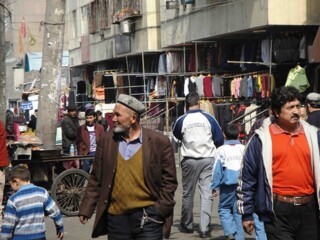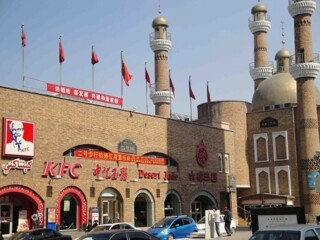Pearl of the Western Region
Nick Holdstock · Regenerating Urumqi
In the past 18 months, Ürümqi, the capital of China’s Xinjiang province, has been subject to riots, syringe attacks, further riots, and an elevated military and police presence. Last week the provincial authorities announced their plans to transform the city into 'a bright pearl of the western region' (perhaps a more achievable task than making the city deserve its name, which means 'beautiful pastureland' in Mongolian). This is part of a general stimulus package, which aims to raise the per capita GDP of Xinjiang to the national average within five years. Though Xinjiang is by no means the poorest province in China, and has considerable oil and gas reserves, Ürümqi has always received a bad press. When Mildred Cable and Francesca French went there in the 1930s they said that ‘the town has no beauty, no style, no dignity and no architectural interest. The climate is violently exaggerated and at no season pleasant.’ Modern visitors are unlikely to feel differently.
The goals of the development programme are as much political as economic. Some of the resentment between Han and Uighurs in Xinjiang stems from the state's repressive religious policies, but it’s also caused by the higher levels of unemployment among Uighurs. One of the main targets of Uighur anger is the bingtuans, the network of state-farms and factories that dominate the region’s economy, but employ virtually no Uighurs. So pouring money into Ürümqi, providing jobs and raising living standards, should reduce the chance of further conflict.
Except that Urumqi, despite being the capital of the Xinjiang Uighur Autonomous Region, is a predominantly Han Chinese city (about three-quarters of the population). The same is true of such surrounding cities as Karamay and Shihezi, which are likely to benefit from the improvements to Urumqi's infrastructure. It is far less certain that any benefits will reach the poorer, more agricultural south of the province, whose population is predominantly Uighur.
But even in Ürümqi the position of Uighurs is increasingly precarious. The demolition of the Grand Bazaar in 2003 deprived the Uighur community of its commercial and cultural hub. The more tourist-friendly complex that replaced it came with a Kentucky Fried Chicken, a Carrefour supermarket, and rents that were too high for most stall-owners, most of whom now trade in the surrounding back streets. 'Slum shantytowns' have been demolished in Heijiashan district, where Uighur migrant workers from other cities used to live. This makes it harder for Uighurs from rural areas to come to the city to work and likely to widen the rural/urban divide. Most Chinese cities have demolished old residential areas to make way for apartment and shopping complexes. But given the current tensions between Han and Uighur in Ürümqi, it is likely to be interpreted as an attempt to displace Uighurs from the city.
Whatever the intent behind the government's plan to transform Ürümqi and the rest of the province, its goal of raising GDP to the national average is likely to come at the price of more inequality within Xinjiang, an even greater north/south divide, and increased Uighur resentment.

